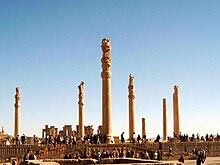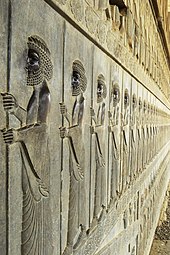Audience Hall Apadana of Darius and Xerxes Ap Art History

Ruins of the Apadana Palace

Reconstruction of the Apadana'southward roof by Chipiez

Reconstruction of the Apadana by Chipiez

Apadana (Old Persian: 𐎠𐎱𐎭𐎠𐎴) is a big hypostyle hall in Persepolis, Iran. It belongs to the oldest building phase of the city of Persepolis, in the commencement one-half of the 6th century BC, as part of the original blueprint by Darius the Great. Its construction was completed past Xerxes I. Modern scholarship "demonstrates the metaphorical nature of the Apadana reliefs as idealised social orders".[1]
Etymology [edit]
Equally a give-and-take, apadāna (Old Western farsi𐎠𐎱𐎭𐎠𐎴, masc.) is used to designate a hypostyle hall, i.e., a palace or audience hall of rock construction with columns. The give-and-take is rendered in Elamite equally ha-ha-da-na and in Babylonian ap-pa-da-an is etymologically ambiguous. It has been compared to the Sanskrit "apadana" (आपादन) which means 'to get in at', and besides to the Sanskrit apa-dhā (अपधा) which means "a hide-out or concealment", and the Greek αποθήκη - apo-thēkē pregnant "storehouse". The give-and-take survived into later periods in Iran, as the Parthian 'pdn(y) or 'pdnk(y) "palace", and outside Iran it still survives in several languages equally loan-words (including the Standard arabic فَدَن (transliteration: fadan) for "palace" and the Armenian aparan-kʿ for "palace".)[ii]
More precisely, nonetheless, this word is the straight ancestor of the medieval and modern architectural term, ayvan/aywan. The Old Persian term 𐎠𐎱𐎭𐎠𐎴, a-pad-an, continuing for "unprotected", refers to the fact that the veranda-shaped construction is open to the outside elements on 1 of its iv sides, and thus 'unprotected' / exposed to the natural elements. This is exactly what the Apadana palace has: open up (columned) verandas on three sides—a unique feature amid all palace buildings at Persepolis. The Parthian and Sasanian architects largely did away with the columns holding up the ceiling of the veranda, replacing them with a barrel vaulting, such as the famous Ayvan of Kisra at Ctesiphon. The later evolution of term into aywan in the mail-Islamic compages that evolved from the one-time "apadana", refers to both columned (such equally the palace of Chehel Sotoun, Isfahan) or barrel vaulted (all the four-aywaned mosques). Similar the former Apadana, the new aywans are also verandas: open to the natural elements on one side.
As a modern architectural and archaeological term, the give-and-take "apadana" is likewise used to refer to Urartian hypostyle halls, such every bit those excavated at Altintepe and Erebuni. These halls predate those from Persia, and it has been proposed that Urartu could be the stylistic origin of the later Persian hypostyle audition halls.[3]
Apadana Palace in Susa [edit]
The Apadana Palace in Susa was built during the reign of Darius around 521 to 515 BC and by his lodge on the Elamite relics in Susa.[four] The walls of this palace are fabricated of clay with a brick facade and its columns are fabricated of stone. Its inner walls were covered with glazed bricks and featured soldiers of the Eternal Guard, a winged king of beasts, and a lotus flower.Of import parts of the Apadana Palace caught burn during the reign of Artaxerxes I (461 BC) and were rebuilt during the reign of Artaxerxes II (359 BC).[5]
Description [edit]


Apadana Palace, Persepolis
The Apadana was the largest building on the Terrace at Persepolis and was excavated by the High german archeologist Ernst Herzfeld and his assistant Friedrich Krefter, and Erich Schmidt, betwixt 1931 and 1939. Important textile relevant to the excavations are today housed in the athenaeum of the Freer Gallery of Art in Washington, DC.
It was most probable the chief hall of the kings. The columns reached 20m loftier and had complex capitals in the shape of bulls or lions. Hither, the nifty king received the tribute from all the nations in the Achaemenid Empire and gave presents in return.
Access to the hall is given by two monumental stairways, on the north and on the east. These are decorated by reliefs, showing delegates of the 23 subject nations of the Persian Empire paying tribute to Darius I, who is represented seated centrally. The various delegates are shown in great particular, giving insight into the costume and equipment of the various peoples of Persia in the 5th century BC. There are inscriptions in Old Persian and Elamite.
Measurements [edit]

Pillar of the Apadana Palace of Susa
The Apadana at Persepolis has a surface of k square metres; its roof was supported past 72 columns, each 24 metres tall. The entire hall was destroyed in 331 BC by the regular army of Alexander the Neat. Stones from the columns were used every bit building material for nearby settlements. Past the outset of the 20th century, only thirteen of these giant columns were all the same standing. The re-erecting of a complete, but fallen column in the 1970s, is now the 14th continuing cavalcade of the Apadana.
The Apadana in Susa was—like the city itself—largely abandoned, and pillaged for edifice material.
Legacy [edit]
The apadana hall influenced the Umayyad architecture. Early mosques built in Persia and Republic of iraq imitate this structure.[six]
Notes [edit]
- ^ G. Root (1986) p. ane.
- ^ R. Schmitt, Apadana i. Term, in Encyclopaedia Iranica
- ^ Henri Stierlin, Hellenic republic, from Mycenae to the Parthenon (Taschen'due south Globe Architecture), 1997. p. 116.
- ^ Persepolis: The Audience Hall of Darius and Xerxes
- ^ The Ancient City of Susa
- ^ Arce, Ignacio (one January 2008). "Umayyad Building Techniques And The Merging Of Roman-Byzantine And Partho-Sassanian Traditions: Continuity And Change". Technology in Transition A.D. 300-650: 491–537. Retrieved 4 April 2019.
References [edit]
- Cool Root, Margaret (1985). "The Parthenon Frieze and the Apadana Reliefs at Persepolis: Reassessing a Programmatic Relationship". American Journal of Archaeology. 89 (1): 103–122. doi:10.2307/504773. JSTOR 504773.
- Schmitt, R; Stronach, D. "Apadana". Encyclopaedia Iranica. Routledge. 2.
External links [edit]
- Oriental Institute Photographic Archives
- The Achaemenians connected
- Persepolis3D, a virtual reconstruction of Apadana
Coordinates: 29°56′06″Due north 52°53′24″Due east / 29.935°Northward 52.890°Eastward / 29.935; 52.890
Source: https://en.wikipedia.org/wiki/Apadana
0 Response to "Audience Hall Apadana of Darius and Xerxes Ap Art History"
Post a Comment